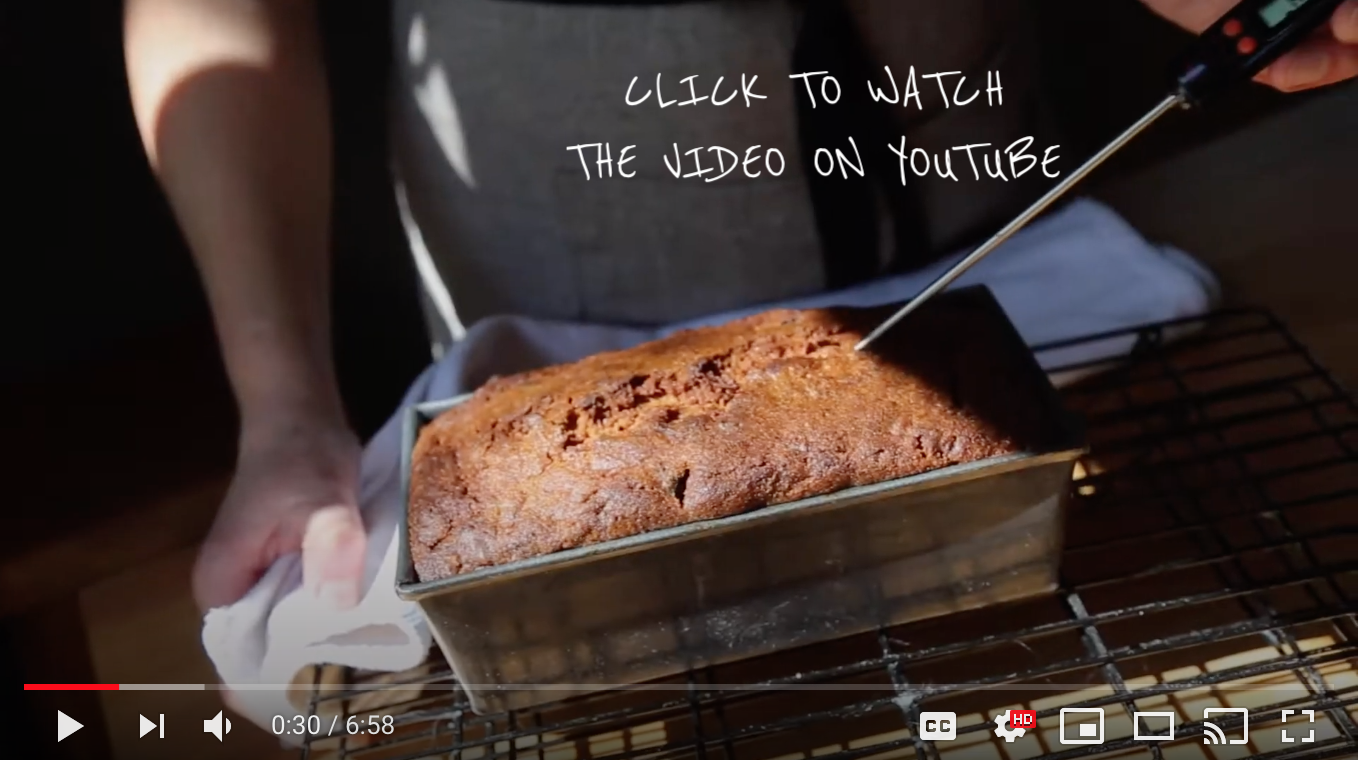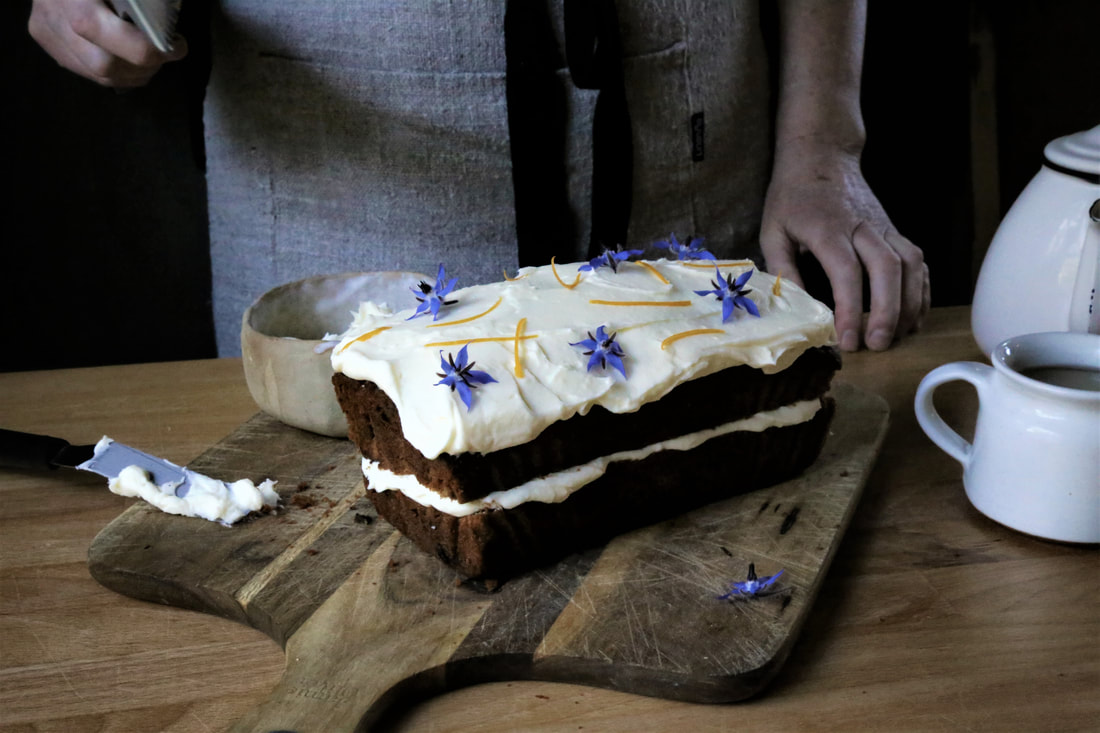|
You'll know by now how much I hate waste! I spend a lot of time developing recipes to use up those ingredients that got overlooked for just a little too long and are seemingly past their best.
This always happens to grapes in our household. The bunches are attacked when they are plump, luscious and firm. But after a while, they wither and people start to avoid them in the fruit bowl. Past their best, they are overlooked and, invariably, find their way into the compost or bin! It's time to see these wrinkly old grapes for what they are: young raisins! Too moist still to be substituted for raisins without further dehydration, but perfect for a wet batter mix such as carrot cake! Et voila! Our grape and carrot loaf cake! A delicious variation of an old favourite: sweet, moist and beautifully textured with seeds and nuts, and complemented by a tangy sour cream frosting. It's an easy all-in-one-bowl batter method. Just take your time preparing all your ingredients before you start, turn your oven on and away you go... Grape and carrot loaf (makes 1 large loaf cake) For the batter: Self raising flour 200g Vegetable oil 170ml Grated carrots 200g ‘Old’ black grapes 80g Pecans 50g Pumpkin seeds 30g Sultanas 50g Granulated sugar 90g Brown sugar 90g Medium eggs 3 Vanilla extract 1 tsp Fine sea salt ½ tsp Cinnamon* 1 tsp Cardamom* 1 tsp Zest of 1 orange Freshly grated nutmeg *(if you don’t have individual spices, substitute with 2 tsp mixed spice overall) For the sour cream frosting: Unsalted butter, softened 150g Icing sugar, sifted 300g Sour cream or crème fraiche 100g Method Preheat your oven to 160°C (140°C Fan)/320°F Firstly sift together your SR flour, spices and salt. Now, place your oil, sugars and eggs together in a mixing bowl and beat together. Stir in your vanilla extract and grated carrots. Depending on the size of your grapes and how wrinkled they have become, either half or quarter them and add to your bowl. Now throw in your nuts, seeds, orange zest and sultanas and combine. Mix the final batter by gradually stirring in your flour/spice mix. Don’t over beat your batter at this stage (you will develop gluten which will make your cake rubbery); the flour just needs to be evenly incorporated. Pour your batter into a greased and lined tin – I like to use a large loaf tin for this cake. Place your cake into the preheated oven. The wet batter mix is going to need long, slow baking at a cooler than usual temperature - approximately 90 mins at 160°C. Check the cake after 80-85 minutes. The cake will appear ‘set’ if gently jiggled, will have shrunk away from the sides and a skewer will come out clean. However, it is far easier to use a digital probe thermometer, which takes the guess work out of baking and avoids the disappointment of a soggy middle or bottom. The cake will be ideally cooked in the range of 96°C - 98°C. At 100°C, the moisture in the cake will begin to evaporate, leaving your cake dry and overcooked. When cooked, leave to cool for twenty minutes or so in the tin and then turn out to cool completely on a wire rack before icing. To prepare the frosting: Make sure your butter is very soft before attempting to mix your icing. Use the butter softening mode on your microwave, if necessary. Then, to the softened butter add your sifted icing sugar and gently blend in. Once incorporated, you can beat your buttercream until light and airy, then beat in your sour cream or crème fraiche. The slight acidity of the cream cuts through the sweetness giving a wonderfully tart edge to your frosting. When the cake is completely cool, frost and decorate your cake with pecans, orange zest or edible flowers. Store somewhere cool - remember the frosting contains fresh dairy. So you've made your starter, and you're rightly proud of this bubbling, fermenting pot of life that you've grown and nurtured. Here is our basic country sourdough recipe. This uses a kneading method. Some days, it just helps to bash out your frustrations on an inanimate lump of dough! Remember, this is sloooooowwww dough. All good things are worth the wait!
Country White Sourdough (makes 1 medium loaf) Plan ahead. Sourdough will always be at least 2 days in the making. Feed your starter about 8 hours (overnight is perfect) before you are ready to make your sourdough, so that it is lively and active before you begin. 300g strong white flour 80g wholemeal flour 120g active starter (liquid, 100% hydration) 250g water 8g fine sea salt Measure your dry ingredients into a large bowl. Place your starter and water in a separate bowl and mix roughly together. Now pour these into the dry ingredients. Mix with your scraper until all the ingredients are combined and a rough dough has formed. Turn out onto your clean work surface and knead for 15-20 minutes until you have an elastic dough which doesn’t stick to your fingers or to the work surface. Alternatively, place in your mixer with the dough hook attachment and mix on medium for about 7 minutes until the dough comes cleanly away from the sides of the bowl. Form the dough into a ball and place back into your lightly floured bowl. Cover with a large plastic bag or a baking cloth and leave to prove. After 30 minutes, fold and stretch your dough: using your scraper, turn the dough carefully out onto a lightly floured surface – with the ‘top’ of the dough now underneath. Taking the 4 points of the compass in turn, pull the dough gently to one side then bring over to the middle point of your dough (as if you were making a paper windmill). When all 4 ‘corners’ have been brought into the middle, turn your dough back over and place back in the bowl, so that the top of the dough remains uppermost. Repeat folding action every half an hour. This is the ‘bulk proof’ stage and should take 3 or more hours. Stretch and fold your dough about 6 times during this stage. Each time you will be building the strength of your dough and improving the final loaf. After 3-4 hours (depending upon ambient temperature) you are ready to shape your dough. Don’t expect it to have doubled in size like a yeasted dough. It will not need de-gassing. Using the round side of your scraper, carefully tip out the dough onto a lightly floured surface, so that the ‘top’ of the dough is now lying underneath on your floured countertop. Shape your loaf by stretching the edge of the dough and bringing onto the middle, like when stretching and folding your dough during the first prove. Go around the entire circle of dough, then flip and place it seem side down on your counter, ensuring there is no flour underneath the seam. Now you can ‘tighten’ your ball by dragging it towards you and allowing the friction of the counter to resist the movement. This should cause the ‘skin’ of your ball of dough to tighten a little. Adjust and do the same in a few different directions around your ball. Do not over-tighten. A few little stretches are all it takes. You don’t want to tear the skin that is containing your dough under tension. When you have a tight ball, place seam side up into a pre-floured proving basket – wholemeal flour works best here, as the bran prevents sticking (do not use rye flour). However, a well-shaped loaf will not stick in your banneton. It is essential that you pay attention to the tightening of the dough at this stage. If your loaf collapses when you tip it out, ready to bake, it could well be you have not tightened sufficiently before placing in the basket. If you have no proving basket, flour a good quality linen cloth well, placed inside a round 1litre bowl (eg Pyrex bowl). This prevents your dough relaxing into a puddle whilst it proves for a second time. Cover with a loose-fitting plastic bag or baking cloth for about 3-5 hours (depending upon ambient temperature) until the dough appears ready. At this stage, the dough will bounce slowly back when pressed gently with a floured finger. If it bounces rapidly back, it needs a little longer. If the indentation remains, you have over-proved your dough. Alternatively, you can place the dough in the fridge when it appears to be nearly ready, say after 3-4 hours, and leave overnight. When the loaves are ready to bake, turn them out onto a lightly dusted peel. Be gentle with your loaves at this stage. Slash the loaves at an oblique angle of about 30 degrees, to allow extra expansion in the oven. Place in a very hot oven, pre-heated to 240°C. As you place the loaves in the oven, spray the walls, ceiling and floor of your oven with water, avoiding the loaves themselves. Now turn down your oven down to 220 °C and bake for 35-45 minutes for the larger, until golden or dark brown, according to preference. Alternatively, bake inside a pre-heated Dutch oven or cast iron casserole dish – the lid will keep in all the steam that is released by the dough during the first 15 mins, after which you can remove the lid and continue to bake and crust over. To check reliably whether your bread is baked, place a probe thermometer into the centre. A loaf will be reliably baked when the thermometer reads 95°C or more. Notes on refreshing your starters: Wheat starter: Wheat starters can be kept in a liquid state (usually 100% hydration) or a stiff state (usually 50% hydration). This recipe uses a liquid starter. To refresh your liquid starter, take 100g of starter (discarding or using the rest) and add 100g water and 100g of flour, ie equal parts flour and water. If using a new recipe, always check whether a stiff or liquid starter is required and adjust your overall water/flour quantities in the recipe, if necessary. Leave the refreshed starter at a warm room temperature for 8-12 hours before using. If it is not required straight away, simply place in the fridge after a few hours. Your starter will keep refrigerated for a couple of weeks (and can even be dehydrated or frozen!), but it is best to refresh it every 7 days even if not being used. Pane Pugliese
(makes 1 large loaf) Although many of my recipes are inspired by the Tuscany region, this recipe is a Southern Italian treasure from the Puglia region. Pane Pugliese is made with either all or the greater part hard durum wheat – fine semolina or ‘semola rimacinata di grano duro’. The finest example of this is Pane di Altamura, now granted PDO (Protected Designation of Origin) status. The loaf is a beautiful pale gold in colour and has the characteristic crumb and crunchy crust of a semolina bread. It is utterly delicious and well worth a try. If you wish, you can use all semolina for this recipe. Simply replace the bread flour in the biga and dough with more semolina. Ingredients Overnight biga: Strong bread flour 100g Tepid water 100g Fresh yeast 2g For the dough: Strong bread flour 100g Fine durum semolina 400g Tepid water 300g Biga, from above 200g Fresh Yeast 10g (or 5g instant dried yeast)* Sea salt 10g *if you intend to prove overnight in the fridge, reduce the amount of yeast to about half. Method The night before, mix together the ingredients for the biga and leave, covered, overnight at ambient room temperature. Make the dough by combining the above ingredients and knead for 10-15 minutes until you have a smooth elastic dough. Leave, covered, in an oiled bowl for 30 mins, after which you can stretch and fold your dough. Cover once more and leave for a further 30 minutes. When your dough has significantly increased in size, after this first prove of about 1 hour, tip it out onto a lightly floured surface and shape tightly into a ball. Place into a floured banneton, cover and leave to prove again for 1 – 1½ hours, depending on ambient temperature. Alternatively, place in the fridge and allow to prove slowly overnight*. Pre-heat the oven to 240°C. When your loaf is ready, slash the top with a sharp knife or baker’s lame and either slide from a peel onto a hot baking stone, or bake inside a preheated cast iron pot. Turn oven down to 220°C and bake for 45-50 minutes. If baking in a cast iron pot, remove the lid after 15 minutes to allow the loaf to develop a golden crust. The loaf will be baked when the crumb reaches 95°C. Leave to cool on a cooling rack. |
Our workshops are run by award-winning sourdough baker Helen Underwood.
Categories
All
Archives
November 2023
|





